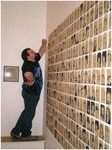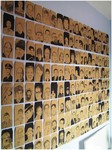'You'll pass in a crowd with a shove' 2008
In this striking exhibition Mat Cahill has fashioned an intricate virtual world where the visual and the written word mingle to produce a mesmerising dystopia. The visitor is accosted by an imposing wall display of around thousand headshots and figures. These delicately constructed characters, each drawn on an individual envelope, further reveal a personal story or confession which we are invited to unveil by opening and exploring the enclosed text. This level of participation elevates the impact of a deeply absorbing piece and reflects the author’s commitment to a mode of art where immediate experience is central and the traditional static product is rejected.
This interaction gives rise to a fluid, dynamic and essentially unique experience to each visitor as he or she navigates this private world.
Cahill, interested in the convergence of fine art and popular culture, scatters and embeds various fragments of mainstream society. The intimate narratives mirror the laser-like beam of soap operas and tabloid gossip pages. Indeed, we are encouraged to physically discover the ‘inside stories’. The content is diverse but it is everyday people rather than celebrities who come into focus. Shifting from humorous reflections to somewhat darker revelations, the first hand accounts are infused with the surreal light of a problem page where even the trivial is magnified, and its significance sharpened, by the honest despair of the bewildered individuals.
The obsessive quality of the work – vast in its volume, range and visual effect – echoes the fears and preoccupations of the inhabitants within the world. The owner and creator draws with the selective exactitude of a forensic investigator, restlessly sifting the details for the decisive clue or key to a character. Nobody can remain on guard continually. A careful and precise pose need only be temporarily torn by sudden unchecked laughter and, in a snapshot, the individual is captured. These tireless, almost relentless depictions are almost reminiscent of certain childhood fixations. The long lines and complex arrangements of faces speckle the wall like a sticker collection. It is not the only hint of the familiar. The artist teases us throughout. The wall of headshots, for some, might well bring to mind the ever proliferating social networking sites such as Facebook and Myspace. It is a common critique of such electronic societies that the collectable commodity here is the ‘friend’.
The faces adorn the covers of brown envelopes. To those uncomfortably acquainted with casual work or labour these, of course, signify the long awaited wage packet. The relationship between an individual and his occupation, that is, between form and function, is brought into question. The anonymity of the employee is seemingly inverted with the characters exposed. Clearly fascinated by themes of community, Cahill is keen to promote a vision where society is central. This is evident in his artistic principles. Influenced to some degree himself by simple yet effective methods from within arts and crafts, he argues forcefully for a democratisation of art where the interactive element conjoined with an increase in accessibility permits a wider, and more fruitful, engagement with the general population.
The population of his world, by contrast, quickly engage the participant. Their eyes do not merely follow you with a stony glare. Indeed, they almost seem engrossed in their own affairs. Some glance furtively around. Others lock eyes through this web of encounters. However, as a consequence, our attention is directed by the emphasis of these interaction. We find ourselves drawn into the network. Pushed and pulled in this or that route we are ushered from one individual to another, tracing a path through the world. This course unifies the relevant characters in a particular way. It is intriguing, therefore, to witness how quickly our consciousness carves and divides this web of potential relations. From clusters to pockets to communities, these chaotic entanglements represent the seeds of a narrative. The participant is presented with an infinite well of possible configurations or human equations. Analysing the different forms of narrative, Cahill juxtaposes the visual with the written. What constraints does the relatively linear nature of the latter place on our interpretation? What impact does the multidirectional and often holistic nature of imagery have? What are the effects of these different modes on our expectations, imagination and understanding? The artist leaves this question open.
Nor does the artist seek to impose a conclusion as to which better embodies an authentic way of modelling society. The stories of the individuals unfold through both forms. What is clear, nonetheless, is that the aesthetic effect of the overall matrix holds dramatic sway over that of any particular individual. Relational forces are central to this piece. Yet there is an awareness throughout of the seemingly paradoxical counter-forces that we witness within the social fabric. Cahill does not downplay the darker side of such structures when left to decay. As anyone who has struggled with institutional bureaucracy can testify, an individual can, somewhat ironically, be left in a state of virtual anonymity and helplessness when part of a large social structure. There seem to be several such characters within his world. One in particular, short in height, barely reaches into his own space. He appears almost submerged in the crowd. The style is consistently clever. Moving from the raw to the methodical, they carefully reflect the character and endow each with a rich sense of their personality. A timid man, tentatively drawn, peers nervously from the corner of another square. He appears paper-thin like a possible cut-out. The traditional authority figures are represented – the Priest and the Policeman – but even they are far from immune from the surrounding world and seem almost overwhelmed. With some characters in fancy dress, such as Batman and a clown, they cannot, furthermore, be read unquestioningly. This interplay leaves the world open.
Text by Andy Routledge


